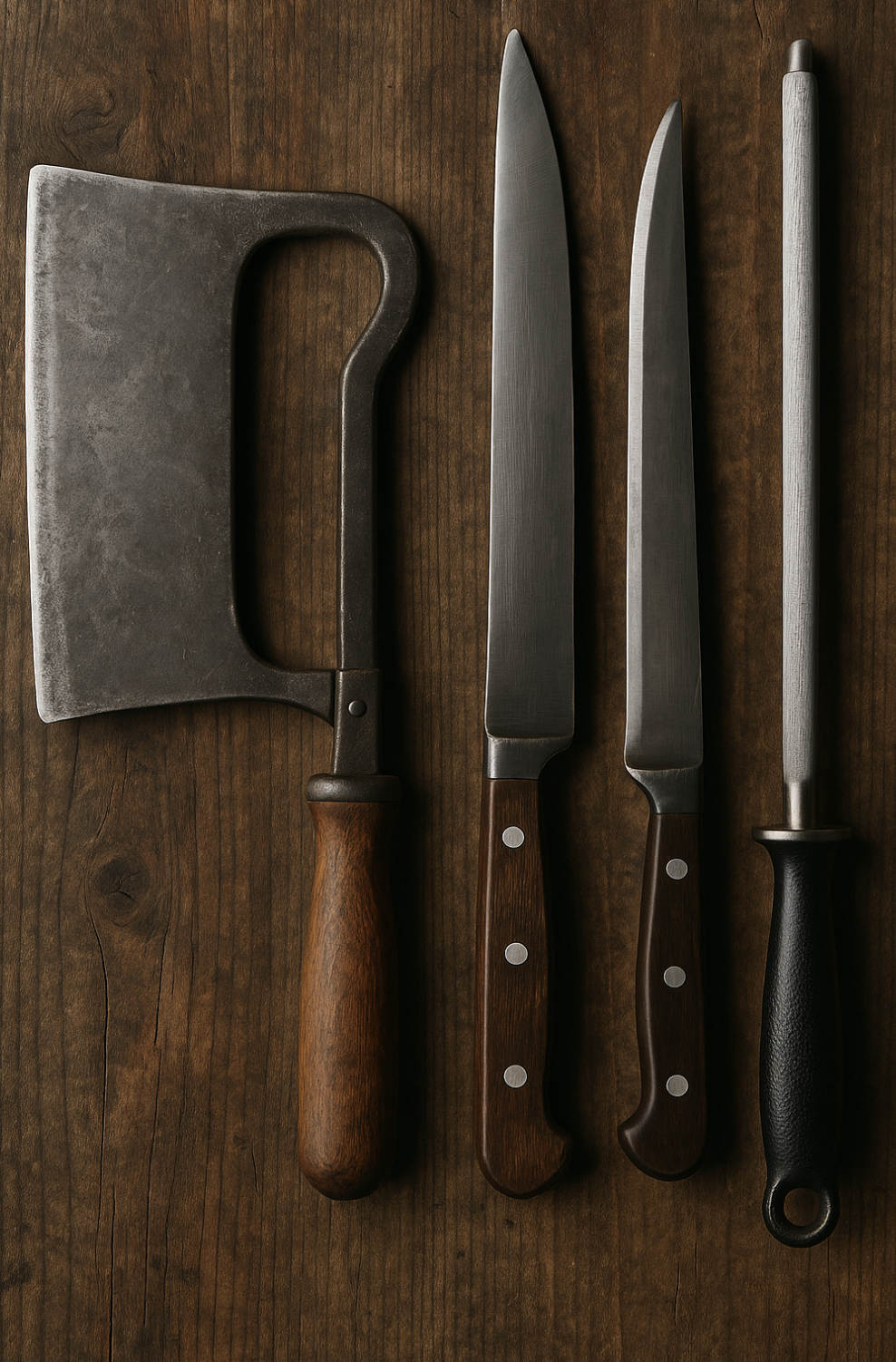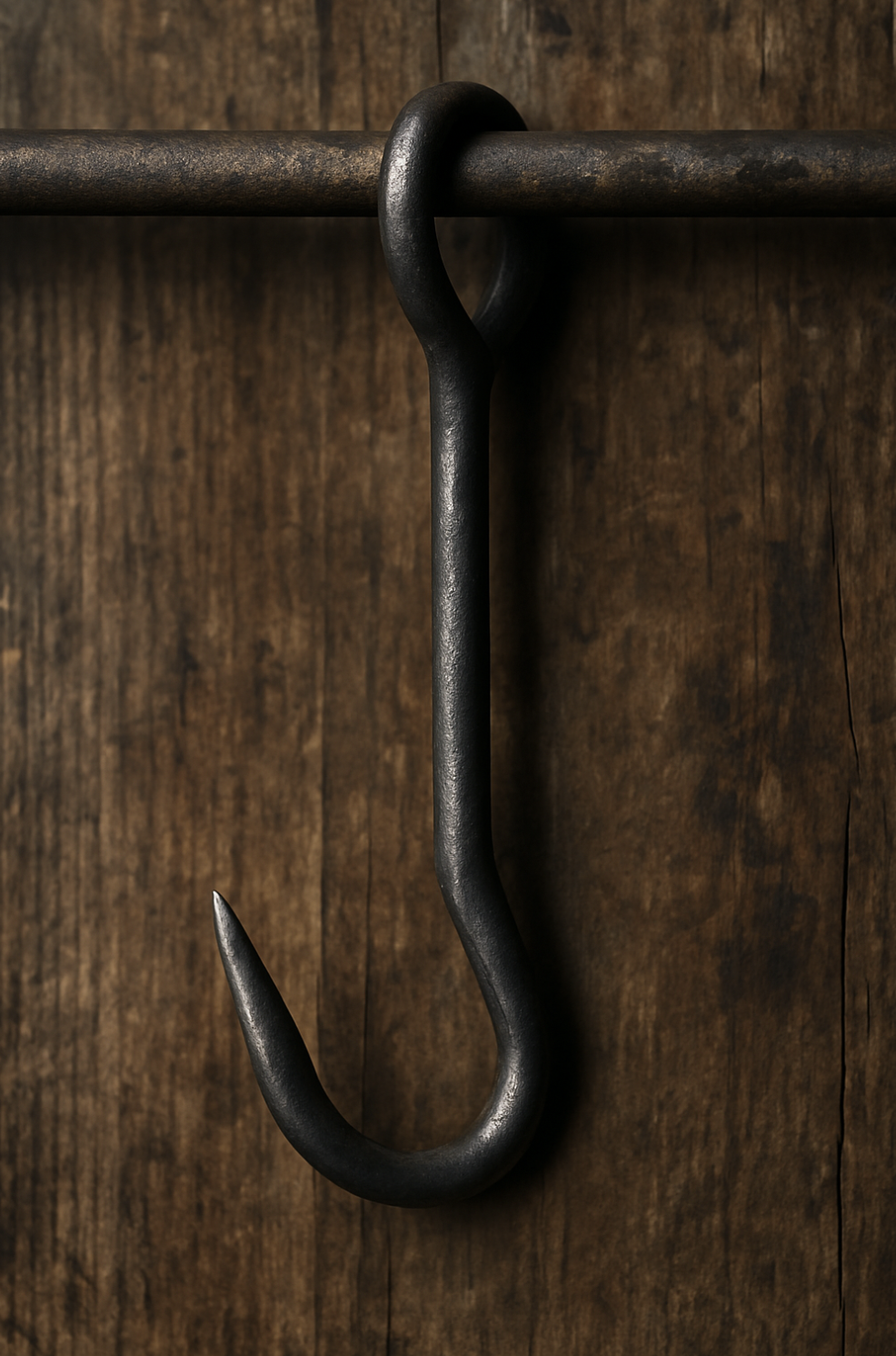The Rise of Artisan Butchery in America: A Return to the Knife, the Hand, and the Animal
There was a time…not long ago, when your meat had a name.
Not the animal, necessarily. But the butcher.
The man or woman behind the counter.
The hands that turned sinew into supper.
The voice that asked if you’d like the pork shoulder tied or loose.
The quiet knowledge passed from bone to blade.
Then came shrink wrap.
Factory cuts.
Plastic trays labeled only with weight and price.
And the knife, once sharp with memory, was dulled into a barcode.
But something is shifting. Slowly. Strongly.
Across the country, a new generation of Americans is putting their hands back on the cleaver.
And they are not just butchers.
They are storytellers. Preservationists. Craftspeople. Priests of the primal.
The Body Is Not a Commodity
Artisan butchery does not rush. It does not hide.
It begins with an animal, not a product.
It honors the full body, not just the tenderloin.
In a world obsessed with speed, this is radical slowness.
A willingness to work nose-to-tail.
To know how to break down a lamb and use every part, from chop to bone to offal.
Artisan butchers aren’t cutting meat.
They’re reading it.
And they are pushing back against the great forgetting:
That meat is not a thing.
It is a life, translated through hands.
Beyond the Supermarket
In sterile aisles beneath fluorescent lights, meat becomes anonymous.
But artisan butcher shops are opening again in Brooklyn. In Boise. In Asheville and Austin.
Shops with names like The Local Butcher, Feather and Bone, Cure & Cut.
Shops where you meet your meat, where you look it in the eye…not with guilt, but with respect.
Where the sausage is mixed in-house.
Where the fat is cured for lardo and pancetta.
Where the chicken is not boneless-skinless by default, but feathered with history.
These are temples of tradition.
But also of innovation.
Grass-fed. Dry-aged. Smoked in-house.
Aged for 60 days.
Wrapped in butcher paper, not shame.
Butchery as Rebellion
To cut meat by hand is now an act of rebellion.
Against mechanized meat.
Against industrial death lines.
Against the pink sludge and filler and “meat glue” that’s passed off as dinner.
Artisan butchery says:
Let us slow down.
Let us slice.
Let us waste nothing.
Let us remember that to eat meat is to make a pact: with death, with life, with land.
And maybe the knife, properly wielded, is not violence.
Maybe it is gratitude, made visible.
The Apprentices Return
In a world of automation, butcher shops are becoming schools again.
Young people are learning the primal cuts.
Not from books, but from elders.
From knives. From muscle memory. From fat under the fingernails.
Butchery apprenticeships are growing…not just in Portland, but in places like Kansas City and Chattanooga.
This isn’t hipster nostalgia.
This is food literacy.
This is the end of the disconnection that tells us meat comes from a truck instead of a life.
And these apprentices aren’t trying to make meat trendy.
They’re trying to make it true.
Women with Knives
The new wave of artisan butchers is not just bearded men in bloodstained aprons.
It is also women.
Women who sharpen blades and break down sides of beef.
Women reclaiming space in what was once deemed too rough, too red.
Their presence changes the room.
Adds grace to the grit.
Not softness, but precision.
And they remind us that butchery isn’t about brute force.
It’s about understanding anatomy.
About listening to tension in the flesh.
About knowing when to cut and when to pull.
And like midwifery, it is a craft built in blood and reverence.
Knife Skills as Language
There’s a rhythm to butchery. A syntax of the wrist. A dialect of the blade.
Every cut is a sentence. Every angle a pause or an exhale.
To learn to butcher well is to learn a language that predates speech.
It is the kind of knowledge passed eye to eye, hand to hand…not through textbooks, but through repetition.
The shoulder yields differently than the loin. The ribs ask for patience.
You don’t fight the meat, you follow it.
Good butchers don’t impose order; they reveal it.
Each animal is a new grammar, and the butcher, a translator.
In an age of machines, this is an act of poetry.
A reclamation of fluency in flesh and fiber.
Waste Nothing: The Rise of the Bone Broth Revolution
Artisan butchery doesn’t end with a steak.
It ends with broth. With marrow. With gelatin cooling in glass jars.
This is the resurrection of a nearly-lost art: using every part.
Bones are no longer tossed, they are boiled with purpose.
Skin becomes cracklings. Organs become pâté.
Even fat (once discarded) is rendered down into lard, slow and fragrant.
It’s not just sustainability. It’s respect.
In this renaissance, every piece has value.
Every bite has lineage.
And what was once called “waste” is now called nourishment.
The Return of the Meat Hook
Walk into an artisan butcher shop and look up.
You’ll see it: the hook.
Not hidden, not sanitized…just there. A tool. A symbol.
It speaks of gravity. Of weight. Of consequence.
Of bodies lifted, not as trophies, but as trust.
Supermarkets took this away. They removed the hanging carcass and gave us tidy portions in cling film.
But the hook returns with a message: this was once a life.
And if you eat meat, it is a life you share in.
The meat hook does not shame.
It simply asks you to see.
To appreciate what
Sausage-Making as Ritual
Once, sausage-making was done in kitchens, backyards, and cellars.
Now, it’s returning…shoulder by shoulder, spice by spice.
There’s something intimate about it. Something ancestral.
The meat is ground, spiced, stuffed, tied.
You taste as you go. You tweak the mix. You lean over the table with your friends.
Sausage-making isn’t just a product, it’s a practice.
And in shops across the country, butcher-led workshops are reviving it.
Paprika-heavy chorizo. Fennel-kissed Italian links. Coarse-ground bratwurst.
These are flavors you can’t buy in bulk.
They come from hands. From hearts. From habit and heat.
Rethinking Meat for a New Generation
Young people are redefining what it means to eat meat.
They don’t want anonymous protein. They want ethics and intimacy.
They ask hard questions: Where was this raised? Was it pastured? Who slaughtered it?
Artisan butchers are rising to meet that curiosity, not with lectures, but with openness.
They show the cut. They tell the farm’s name.
They offer chicken feet and lamb necks without flinching.
They say: “Here. This is the truth. It’s beautiful if you let it be.”
This is not carnivory for the sake of appetite.
This is meat with a mind.
And it’s changing the culture…cut by intentional cut.
A Sensory Resurrection
Artisan butcher shops are noisy. Warm. Alive.
You hear knives on boards. Paper tearing. Orders called out.
You smell smoked pork, dry-aged beef, vinegar tang from pickled garlic.
There’s music, often. Laughter.
A far cry from the cold sterility of vacuum-packed aisles.
This is meat as a sensory event.
The kind that stays with you.
The kind that reminds you food is not sterile.
It is sound. It is steam. It is smell and story.
And when you bring it home, the experience doesn’t stop, it just shifts to your pan.
Why Butchers Are the New Historians
In their cuts, butchers carry history.
Not just of the animal, but of a region, a tradition, a people.
A Carolina hog yields different flavor than a Berkshire boar.
A Texas butcher knows brisket like a fisherman knows tide.
Through technique and choice, butchers preserve culinary memory.
They are the ones who remember the old cuts: Denver steak, oyster blade, lamb saddle.
They know which bones make better broth, which roasts deserve a long braise.
They are custodians of taste…ot trend.
And in a world of disposable food, that makes them radical keepers of something sacred.
Meat With Meaning
Artisan butchery doesn’t claim moral superiority.
It doesn’t pretend meat is gentle.
But it insists that meat should be meaningful.
A roast that took hours to tie and season.
A broth made from bones that once stood.
A dinner that remembers it came at a cost, and honors it.
This is not “farm-to-table.”
This is life-to-knife.
And it may be the only way forward in a world slowly forgetting how to feed itself.
Tools for You:
Butcher Knife
Mercer 10-Inch Granton Edge Butcher Knife
A trusted classic among artisan butchers—sharp, balanced, and built to break down primal cuts with grace.
Boning Knife
Mercer Culinary Genesis 6-Inch Boning Knife
For the delicate, intentional work—tracing bones, not hacking them.
Knife Honing Rod
Wüsthof 10-Inch Sharpening Steel
Because artisan butchery demands respect—for the blade and the craft.
Butcher Paper Roll
Pink Butcher Paper Roll by Meat Hugger
Authentic butcher wrap for meat that deserves better than plastic.
Bone Broth Starter Kit
Slow Cooker Bone Broth
I Encourage you to use the bones—make broth, not waste.
Cutting Board (Teak or Maple)
TeakHaus Edge Grain Cutting Board
Heavy, durable, and made for the weight of real cuts—not decorative cheese cubes.
Related Reads from the Archive:
What Did Ancient Egyptians Eat? A Look Inside a Pharaoh’s Pantry
Brazil’s Supercows: Science, Beef, and the Strange March Toward Genetic Domination
The Forgotten Food Pyramid: What Happened to Real Nutrition?
The Hidden Violence in Our Food Chain (Even When It’s Vegan)
The Foods That Remember You: How Ultra-Processed Cravings Are …

